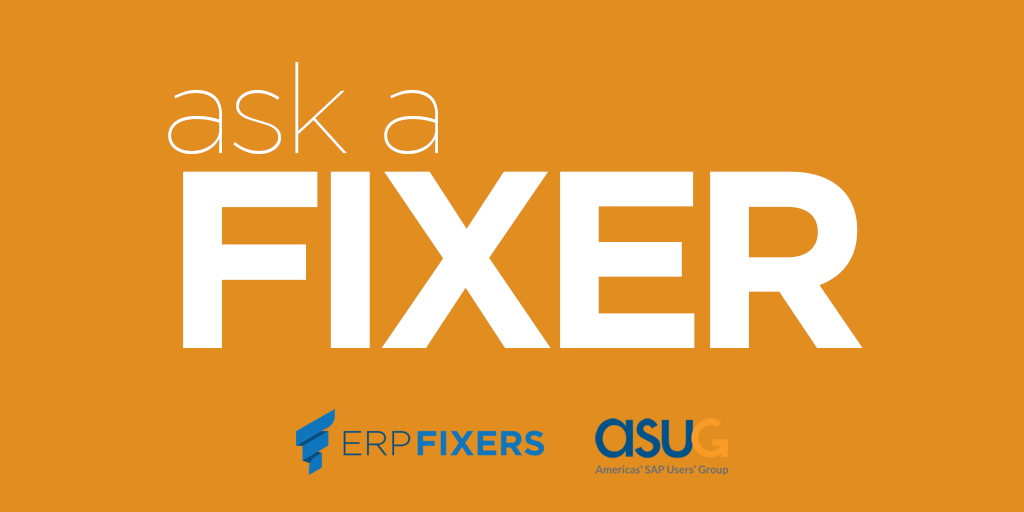One of the most misunderstood aspects in all of SAP is how to analyze production variances. This is partly because SAP’s method of Product Cost Controlling is different from other accounting software systems, in that production costs are passed through the P&L as well as the Balance Sheet. And also, because production activity (Labor, Machine Time, Overhead) is tracked using Secondary Cost Elements, which are not part of your typical Financial Statements. Even some of the most seasoned cost accountants are flummoxed with how the manufacturing information is represented in Financial and Management Accounting, and how to measure price and efficiency variances. To put it simply, Production Variance Analysis involves three steps:
Creating a standard cost estimate, which calculates the expected cost to manufacture an assembly.
Collecting the Actual manufacturing costs on a manufacturing order (production order/process order /product cost collector).
Calculating the Variance, which is the difference between:
actual costs: components, labor, overhead
actual credits: value of finished goods manufactured.
Gain better Visibility of Inventory Costs within your ERP System
In the standard ERP system (and even S/4HANA) it is difficult to find reports that give you a multidimensional view of your inventory costs. Many customers download the information to Microsoft Excel or use external reporting tools such as BI to do the analysis. There is nothing wrong with these options, but sometimes they lead to reconciliation errors (in the case of Excel) or realtime update issues (in the case of BI). With the Material Ledger Activated and by utilizing an enhanced report, there are several reporting options that will give you a more granular view of your inventory values.
Recording Stock-in-Transit in Accounting and Logistics Transactions
Stock-in-Transit can occur when goods transferred between two entities have left the sending entity, but ownership has not yet been transferred to the receiving entity. In traditional SAP the Stock-in-Transit of Inventory can be identified in Inventory Management reports, but this is not reflected in Accounting. With the Business Function LOG_MM_SIT, which is available in ECC (from Enhancement Pack 5) and also in S/4HANA (switched on by default), you can reflect the Stock-in-Transit in dedicated G/L Accounts.
Reorganizing Profit Centers in SAP
As of ECC 6 EHP 5, SAP rolled out a functionality which allows for reorganization of the profit center on the core SAP objects in the Logistics and Accounting functions.
This includes changing profit centers on Materials, Sales Orders, Cost Centers, Orders, Projects, AR, AP, and GL Open Items. With this functionality companies can update the core data in their SAP ERP systems to enable financial reporting which better aligns with how they manage their business today versus 10-15 years ago when they first implemented SAP. Learn how SPX Flow used this functionality to transform their financial reporting and enable full financial statements which align with a new management structure.
Universal Allocations in S/4HANA
Cost Allocation within the Overhead Cost Controlling module enables business users to periodically allocate posted amounts and quantities from sender cost objects to receiver cost objects based on a Cycle Structure. Some challenges exist with the current ECC functionality such as the ability of users to easily understand their allocation processes and the ability to simulate the results from allocations. Also, several other modules such as General Ledger, Profit Center Account, and Profitability Analysis also contain allocation functionality, but it is difficult to keep track of all the allocations, as they are not stored in the same area of the system. In S/4HANA 1809, Universal Allocations were introduced to handle most of these issues as well as provide new functionality.
SAP's RE-FX Contract Lease Management Solution
WALK AWAY FROM THIS SESSION WITH AN UNDERSTANDING OF SAP's RE-FX Contract Lease Management Solution
The FASB released new lease accounting standards taking effect:
- After December 15, 2018 for US public companies and
- Delayed to December 15, 2021 for US private and nonprofit companies*
- Lease contracts move from a footnote in financial statements to the balance sheet as right-to-use (ROU) assets
- SAP's existing Real Estate module (RE-FX) incorporates the new process and reporting requirements
- This webinar informs you of 5 things you may not know, but should, about implementing the new lease accounting standard and SAP's RE-FX solution:
- Things to do before your implementation
- Things to avoid that complicated public company
implementations
- S/4HANA versus ECC6 and on- premise versus
cloud
- Things to remember about SAP's RE-FX
configuration
S/4 HANA: Costing for Manufacturing Orders
WALK AWAY FROM THIS SESSION WITH AN UNDERSTANDING OF DISTRIBUTING COSTS DURING PERIODS OF IRREGULAR PRODUCTION ACTIVITY
There are certain scenarios where the activities of a business are not aligned with the period when the costs for those activities are incurred. This occurrence is typical with companies with seasonal production cycles, such as those in the Agribusiness industry, whose investments in land or other resources, do not always coincide with when the utilization of those resources occurs. In those cases, a cost model is set up so that the original cost is spread through the periods of the production cycle, when the actual cultivation of the land takes place.
In these times, where disruption due to COVID 19 has impacted many industries and hence production activities, the model described above could also be useful. During periods of Production Downturn which leads to minimal or no activity, how do you reflect that in a cost structure that had assumed that production will take place? Hear from Rogerio Faleiros, SAP Controlling Expert and Author, who will take you through the following:
- Using Assessments between Cost Centers and Internal
- Orders for Operational Expenses
- Using Internal Order Settlement to transfer Costs to AUCs
- Setting up Depreciation Rules to reflect periods of Uneven
Production
- Using the Allocation Structure to Distinguish Between
- Different Types of Costs
How to Distribute Costs During Periods of Irregular Production Activity
WALK AWAY FROM THIS SESSION WITH AN UNDERSTANDING OF DISTRIBUTING COSTS DURING PERIODS OF IRREGULAR PRODUCTION ACTIVITY
There are certain scenarios where the activities of a business are not aligned with the period when the costs for those activities are incurred. This occurrence is typical with companies with seasonal production cycles, such as those in the Agribusiness industry, whose investments in land or other resources, do not always coincide with when the utilization of those resources occurs. In those cases, a cost model is set up so that the original cost is spread through the periods of the production cycle, when the actual cultivation of the land takes place.
In these times, where disruption due to COVID 19 has impacted many industries and hence production activities, the model described above could also be useful. During periods of Production Downturn which leads to minimal or no activity, how do you reflect that in a cost structure that had assumed that production will take place? Hear from Rogerio Faleiros, SAP Controlling Expert and Author, who will take you through the following:
- Using Assessments between Cost Centers and Internal
- Orders for Operational Expenses
- Using Internal Order Settlement to transfer Costs to AUCs
- Setting up Depreciation Rules to reflect periods of Uneven
Production
- Using the Allocation Structure to Distinguish Between
- Different Types of Costs
Asset Accounting in SAP S/4HANA
SAP S/4HANA has brought about a number of improvements in Asset Accounting. There is a tighter integration with Finance, and postings are now real-time, updating all ledgers at the same time as the asset, allowing a smoother period end and an easier migration.
This is a new webcast, to update the original “Ask a Fixer: What You Should Know About New Asset Accounting with SAP S/4HANA” created in 2017. It explains the previous material in a new way, and in addition, covers new transactions for closing and migration. It also introduces the new Fiori “experience”, which brings additional functionality such as the asset accounting overview and embedded analytics.
Executing the Steps for Migrating to S/4HANA Finance
One of the key tasks when migrating to S/4HANA is to convert your Financial data from the old tables in ECC to the new tables (particularly the Universal journal) in S/4HANA. This process usually takes place after the technical upgrade from ECC to S/4 and is done during a downtime period. It involves a series of transactional steps that are executed in sequence, with progression to the next step only possible when a previous step has been executed successfully or confirmed. Several iterations of a Finance Migration need to be done in a Sandbox (or test) system in order to resolve any issues that arise. This will therefore make the eventual Production migration smoother and easier to accomplish during the downtime window. It is therefore important to know what steps are carried out and the types of errors that could occur.
Design and Configuration Changes In Controlling with S/4HANA
WALK AWAY FROM THIS SESSION WITH AN UNDERSTANDING OF DESIGN AND CONFIGURATION CHANGES IN CONTROLLING WITH S/4HANA.
Presenter will share important design and configuration changes in Controlling with S/4HANA, including: Cost Element part of G/L Account; Account Based Profitability Analysis; Material Ledger mandatory; Cost of Goods Sold by cost component; Production variances by category. • In ECC, Cost Elements are created within Controlling module; with S/4HANA Finance, Cost Elements are now part of G/L Account.• In ECC, Costing-based CO-PA has several advantages over Account-based CO-PA and had therefore been a preferred choice for majority of the clients; with S/4HANA Finance, most limitations of Account-based CO-PA have been addressed.• In ECC, Material Ledger is optional, which includes Actual Costing functionality which calculates Actual Cost / Periodic Unit Price; with S/4HANA Material Ledger is mandatory (Price Determination 2 – Transaction-based); but Actual Costing is still optional (Price Determination 3 – Single-/Multilevel).• In ECC, costing-based CO-PA allows visibility of various cost components in profitability reports, but in FI, only one line item is visible for COGS; with S/4HANA’s account-based CO-PA, different cost components can be mapped to multiple general ledger accounts.• In ECC, all production variances are bundled and posted to one price difference (PRD-PRF) account; analysis of variances is carried using Controlling reports; with S/4HANA, variances can be posted to different G/L accounts.
Using the Prediction and Commitment Extension Ledger for Sales and Purchase Orders
WALK AWAY FROM THIS SESSION WITH AN UNDERSTANDING OF THE PREDICTION AND COMMITMENT EXTENSION LEDGER FOR SALES AND PURCHASE ORDERS PAGE.
Watch this pre-recorded webcast with FI/CO expert Paul Ovigele to learn:
· The different types of Extension Ledger and what they can be used for
· The difference between Predictive Analytics and predictive accounting
· How to Set up the Extension Ledger for Prediction and Commitments
· How the Extension Ledger works with Sales Order postings
· How the Extension Ledger works with Purchase Order postings
Planning Your Finance Migration From SAP ECC to SAP S/4HANA
To help organizations through the SAP ECC to SAP S/4HANA journey, ERPFIXERS and Winshuttle have joined forces for a webinar to discuss our views on the tools, tricks, and processes that can help companies.
Watch this webinar to understand the complex challenges and choices involved in making the finance transition from ECC to S/4HANA as smooth as possible.
Q&A: Enable Cost Component Split in G/L Accounts – Before SAP S/4HANA!
The Cost Component Split allows for granularity of the cost drivers in your inventory and cost of goods sold. The cost components can be seen in various reports in Product Cost Planning and Material Ledger. However, this breakdown has not been available in the General Ledger before SAP S/4HANA. By utilizing a Custom Enhancement, the Cost Component Split by G/L Account can be available in the ECC system. This will provide suitable transparency about cost drivers in the General Ledger, particularly for companies that do not plan an S/4 conversion for a few years, and also positions them with a Splitting Structure that is compatible for an eventual S/4 Conversion. This functionality can be used to split cost components for COGS accounts as well as Inventory accounts (which means that you can get transparency into how much material stock or Fixed costs are sitting in inventory). Also, this functionality can be used whether a company uses Material Ledger or not (i.e. it can be used for Standard and/or Actual cost components). Watch this pre-recorded live Q&A with FI/CO expert Rogerio Faleiros to learn:
The things to consider when deciding whether to split COGS in the G/L Accounts.
How to map the original COGS account to the Cost Component Split Accounts.
A demo of the Cost Component G/L Split program and how to view the General Ledger postings.
The Reports that can be used to display the COGS documents that have been split.
Ask A Fixer: Enable Cost Component Split in G/L Accounts – Before SAP S/4HANA!
Attend this live Q&A with FI/CO expert Rogerio Faleiros to learn:
The things to consider when deciding whether to split COGS in the G/L Accounts.
How to map the original COGS account to the Cost Component Split Accounts.
A demo of the Cost Component G/L Split program and how to view the General Ledger postings.
The Reports that can be used to display the COGS documents that have been split.
Q&A: Setting Up Transfer Pricing Between Plants
Transfer pricing is a widely used functionality which sets a price between affiliated entities. It is typically setup for cross border transactions and need to conform with the tax laws in the respective countries. However, in SAP Transfer Pricing can also be set up between profit centers (and plants). In this regard it is used as an internal mechanism that treats every transfer between profit centers as a sale and helps facilitate full management reporting by a plant, or group of plants.
Attend this live Q&A with FI/CO expert Paul Ovigele, to learn the following:
What needs to be set up for Transfer Pricing between Profit Centers?
How is standard cost calculated for Profit center Transfer Pricing?
How does a Transfer Pricing Posting look in the profit center View?
What are the options to convert to Profit Center Transfer Pricing in S/4 HANA?
Ask A Fixer: Setting Up Transfer Pricing Between Plants
EXCLUSIVELY FOR ASUG MEMBERS!
Start: Wednesday, February 20th, 2018 12:00 PM (CT), 1:00 PM (ET), 11:00 AM (MT), 10:00 AM (PT)
End: Wednesday, February 20th, 2018 1:00 PM (CT), 2:00 PM (ET), 12:00 PM (MT), 11:00 AM (PT)
Transfer pricing is a widely used functionality which sets a price between affiliated entities. It is typically setup for cross border transactions and need to conform with the tax laws in the respective countries. However, in SAP Transfer Pricing can also be set up between profit centers (and plants). In this regard it is used as an internal mechanism that treats every transfer between profit centers as a sale and helps facilitate full management reporting by a plant, or group of plants.
Attend this live Q&A with FI/CO expert Paul Ovigele, to learn the following:
What needs to be set up for Transfer Pricing between Profit Centers?
How is standard cost calculated for Profit center Transfer Pricing?
How does a Transfer Pricing Posting look in the profit center View?
What are the options to convert to Profit Center Transfer Pricing in S/4 HANA?
Speaker:
Paul Ovigele, FI/CO Expert, ERPfixers
WHAT IS "ASK A FIXER" WEBCAST SERIES?
Ask a Fixer is a live ASUG-hosted Q&A session with one of ERPfixers’ top-rated SAP experts (“Fixers”) in a specific module or topic. In this real-time discussion session, you have the opportunity to pose your specific questions to a Fixer, who will provide an immediate answer during the forum. This is a great way to get quick answers to your pressing issues, as well as learn from questions posted by other users during the forum.
If you cannot attend: The webcast will be recorded. The link to the recording will be posted here and emailed to all registrants.
Q&A: Deep Dive into the Universal Journal
By now, everyone has heard about the Universal Journal. It is a revolutionary change of the table structures in the Financials modules. Although the conceptual understanding is widely spread, how about the practical aspects of it? How can you get better, more integrated Realtime reports across the various modules such as Financial Accounting, Controlling, Material ledger and Profitability Analysis among others?
Watch this prerecorded Webcast Q&A with FI/CO expert Paul Ovigele, to learn the following:
How does the Universal Journal replace previous FI/CO reporting?
What reporting options do you have with the Universal Journal Table ACDOCA ?
What are the new functionalities of S/4 HANA that can be viewed in the Universal Journal?
What are the Multidimensional Capabilities of the Universal Journal?
Ask A Fixer: Deep Dive into the Universal Journal
EXCLUSIVELY FOR ASUG MEMBERS!
Start: Thursday, January 31st, 2018 12:00 PM (CT), 1:00 PM (ET), 11:00 AM (MT), 10:00 AM (PT)
End: Thursday, January 31st, 2018 1:00 PM (CT), 2:00 PM (ET), 12:00 PM (MT), 11:00 AM (PT)
By now, everyone has heard about the Universal Journal. It is a revolutionary change of the table structures in the Financials modules. Although the conceptual understanding is widely spread, how about the practical aspects of it? How can you get better, more integrated Realtime reports across the various modules such as Financial Accounting, Controlling, Material ledger and Profitability Analysis among others?
Attend this live Q&A with FI/CO expert Paul Ovigele, to learn the following:
How does the Universal Journal replace previous FI/CO reporting?
What reporting options do you have with the Universal Journal Table ACDOCA ?
What are the new functionalities of S/4 HANA that can be viewed in the Universal Journal?
What are the Multidimensional Capabilities of the Universal Journal?
Speaker:
Paul Ovigele, FI/CO Expert, ERPfixers
WHAT IS "ASK A FIXER" WEBCAST SERIES?
Ask a Fixer is a live ASUG-hosted Q&A session with one of ERPfixers’ top-rated SAP experts (“Fixers”) in a specific module or topic. In this real-time discussion session, you have the opportunity to pose your specific questions to a Fixer, who will provide an immediate answer during the forum. This is a great way to get quick answers to your pressing issues, as well as learn from questions posted by other users during the forum.
If you cannot attend: The webcast will be recorded. The link to the recording will be posted here and emailed to all registrants.
Q&A: Transitioning from Costing to Account Based CO-PA
THIS PRESENTATION WITH Paul Ovigele WILL COVER:
What is the difference between Costing and Account Based CO-PA?
What are the advantages and disadvantages of Costing vs. Account Based CO-PA?
What are the implications of activating both types of CO-PA?
What are the steps to transition from one type of CO-PA to the other?
Speaker:
Paul Ovigele, FI/CO Expert
Watch the prerecorded webcast by pressing play:
Get answers to the following questions asked in our Q&A:
Q: If you have BW based on Costing Based CO-PA, will this work for Account Based CO-PA?
Q: Can you still use Costing Based COPA in S/4 HANA?
Q: Is there an advantage of going to Account Based COPA before S/4?
Q: Comment on the 1809 release and the sort of merge of account based and cost based COPA
Q: Why activation of actual costing is optional in S4 HANA and can you provide a specific example?
Q: Did I hear you say there is no quantity from SD billing in universal journal in account based PA?
Q: Costing based COPA allows for than one UoM per transaction. (e.g. 25 bottles or 2500ml) In ECC6 it seems account based Copa allows only one UoM per transaction. How about S4Hana?
Q: If we currently have Costing Based COPA, and if we will shift to dual Costing+Account Based, how will historical data be migrated?
WHAT IS "ASK A FIXER" WEBCAST SERIES?
Ask a Fixer is a live ASUG-hosted Q&A session with one of ERPfixers’ top-rated SAP experts (“Fixers”) in a specific module or topic. In this real-time discussion session, you have the opportunity to pose your specific questions to a Fixer, who will provide an immediate answer during the forum. This is a great way to get quick answers to your pressing issues, as well as learn from questions posted by other users during the forum.








